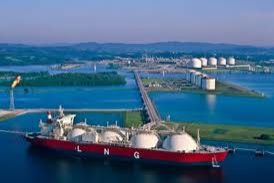Ukrainian Crisis Has Some Wanting Rapid US Approval To Export Natural Gas, But Process Is Slow

The Ukrainian crisis is fueling the argument for U.S. natural gas exports, as a ready supply of gas to Europe from the U.S. would diminish Russia President Vladimir Putin's hold over the region.
The Obama administration has approached natural gas exports cautiously, as some Democrats, environmentalists and American manufacturing companies worry that natural gas exports would raise the price of gas domestically and that the process used to extract it, hydraulic fracturing, may contaminate water sources. Republicans and major oil and gas producers are urging the president to speed up gas exports.
Dozens of companies have begun the approval process to export natural gas, but the Energy Department has been slow to grant authorizations, and the earliest any company will export LNG is late 2015.
So what does that process look like?
The Natural Gas Act of 1938, as amended, requires anyone who wants to import or export natural gas from or to another country to obtain authorization from the Department of Energy (specifically the Office of Oil and Gas Global Security and Supply, Division of Natural Gas Regulatory Activities).
There are two types of authorizations: blanket and long-term. The blanket authorization allows a company to import or export on a short-term basis, for two years maximum, and the long-term authorization can be given to a company that has signed an agreement resulting in the imports or exports of natural gas for a period of time longer than two years.
Generally, federal law requires the DOE to approve natural gas exports to the 20 countries that have Free Trade Agreements (FTAs) with the U.S., and for countries that do not have FTAs with the U.S., the Natural Gas Act directs the DOE to approve exports unless the Department believes the exports “will not be consistent with the public interest.”
As of Feb. 11, the DOE has approved 32 applications for exporting LNG to countries with FTAs with the U.S., and of those, six applications for exporting LNG to countries without FTAs with the U.S.
But of those six applications, only one has full, final approval as of Feb. 21 from the federal government, because for a company to export LNG, it also needs to build what’s called a liquefaction plant, a giant freezer. That requires approval from the Federal Energy Regulatory Commission (FERC). FERC has so far approved only one application, for Sabine Pass Liquefaction, LLC in Sabine Pass, La., across the river from Port Arthur, Texas.
The Sabine facility is under construction and is scheduled to begin exporting LNG in late 2015. Sabine Pass Liquefaction was founded in 2010, is based in Houston and is a subsidiary of Cheniere Energy Investments, LLC. Sabine Pass Liquefaction plans to construct six trains to treat, liquefy, store and export natural gas.
The other five applications, if approved soon, would not export LNG until 2017. They include:
Freeport LNG Expansion, LP and FLNG Liquefaction LLC in Freeport, Texas
Houston-based Freeport LNG Expansion and its liquefaction unit have two Energy Department-approved applications because a second application was required to request to export an additional 1.4 bcf of LNG from new trains. The company signed an agreement in February 2013 with the U.K.-based BP PLC to export 4.4 million metric tons a year of LNG from its Freeport terminal. In the 20-year agreement, BP would retain an exclusive right to process natural gas at one of Freeport’s three planned liquefaction plants. Freeport still needs approval from FERC.
Lake Charles Exports LLC in Lake Charles, La.
Lake Charles Exports is a venture between the U.K.-based BG Group PLC and the Texas-based Energy Transfer Equity LP. It plans to ship up to 2 billion cubic feet a day from Lake Charles.
Dominion Cove Point LNG, LP near Lusby, Md.
Dominion Cove Point, operated by Dominion Resources Inc., has an offshore LNG shipping terminal, where it has been receiving and storing LNG imports. Dominion Resources plans to spend up to $3.8 billion to modify the terminal and export LNG off the shores of Chesapeake Bay.
Cameron LNG, LLC in Cameron, La.
Cameron LNG is owned by Sempra Energy and won DOE approval just last month. Cameron plans to export up to 1.7 billion cubic feet per day for up to 20 years once its terminals are constructed and working at full capacity.
© Copyright IBTimes 2024. All rights reserved.




















